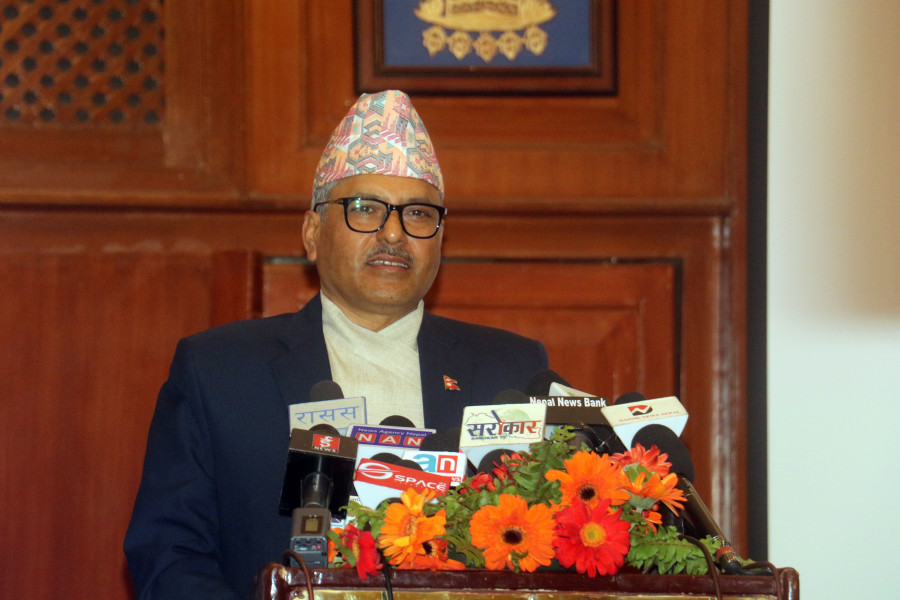Money
Nepal’s financial sector is ‘sound and secure’, says central bank governor
The improved performance of the economy, however, will take some time to be visible in the market.
Post Report
While the private sector complained that Nepal's economy is not performing well, the central bank, on Tuesday, asserted that things were on track.
“Everything is on the right track," Nepal Rastra Bank Governor Maha Prasad Adhikari said at a news conference in the capital.
Adhikari said the major financial indicators of the country during the first eight months of the current fiscal year had shown improvements.
“Our financial sector is sound and secure and is able to withstand the minor shocks,” said Adhikari. “We are hopeful that the current trend will continue in the coming days.”
Adhikari was speaking to reporters briefing them on the current economic condition of the country following the appointment of Pushpa Kamal Dahal as prime minister in December last year.
The central bank governor said the voices from the private sector have been getting louder regarding the high interest rates on loans.
"It is not in the hands of the Nepal Rastra Bank to change the rates. The central bank has left the rates to be determined by the market itself for the past 33 years.
The interest rates depend on the status of the loanable funds," Adhikari said.
The country’s economy has been in recovery mode, but it would still take some time for the effects of improvement to be visible in the market, he added.
Nepal’s remittance earnings increased 25.3 percent to Rs794.32 billion in the first eight months of the current fiscal year, compared to the same period last year.
The remittance inflows have increased because the number of Nepalis opting for foreign jobs has risen sharply.
In the first eight months of the current fiscal year, the labour permits, including the renewed entry, were issued to 544,320 Nepalis. Labour migrations to India, however, are not taken into account.
As a result of the increased remittance earnings, the gross foreign exchange reserves went up 15.2 percent to Rs1,401.21 billion in mid-March 2023 from Rs1,215.80 billion in mid-July 2022, the central bank said.
Of the total foreign exchange reserves, the reserves held by Nepal Rastra Bank increased 17.8 percent to Rs1,244.94 billion in mid-March 2023 from Rs1,056.39 billion in mid-July 2022.
Reserves held by banks and financial institutions, however, decreased 2 percent to Rs156.27 billion in mid-March 2023 from Rs159.41 billion in mid-July 2022.
Based on the imports during the first eight months of fiscal year 2022-2023, the foreign exchange reserves of the banking sector are sufficient to cover the prospective merchandise imports of 10.9 months, and merchandise and services imports of 9.4 months.
The central bank said the current account remained at a deficit of Rs44.31 billion in the review period compared to a deficit of Rs460.72 billion in the same period of the previous year.
In the review period, the net foreign direct investment (FDI) stagnated at Rs1.17 billion. In the same period of the previous year, the net FDI amounted to Rs.16.3 billion.
The country’s balance of payments remained at a surplus of Rs148.11 billion in the review period as compared to a deficit of Rs258.64 billion in the same period of the previous year.
The central bank said the year-on-year consumer price inflation remained at 7.44 percent in mid-March as compared to 7.14 percent a year ago.
Food and beverage inflation stood at 5.64 percent whereas the non-food and service inflation rose to 8.87 percent in the review month.
Under the food and beverage category, the price index of cereal grains and their products sub-category increased by 14.35 percent, restaurant and hotel by 14.09 percent, spices by 10.88 percent, tobacco products by 10.83 percent, and alcoholic drinks by 8.78 percent.
Under the non-food and services category, the price index of transportation sub-category increased by 13.23 percent, health by 10.39 percent, housing and utilities by 9.72 percent, recreation and culture by 8.81 percent, and furnishing and household equipment by 8.79 percent.




 18.12°C Kathmandu
18.12°C Kathmandu












%20(1).jpg&w=300&height=200)
